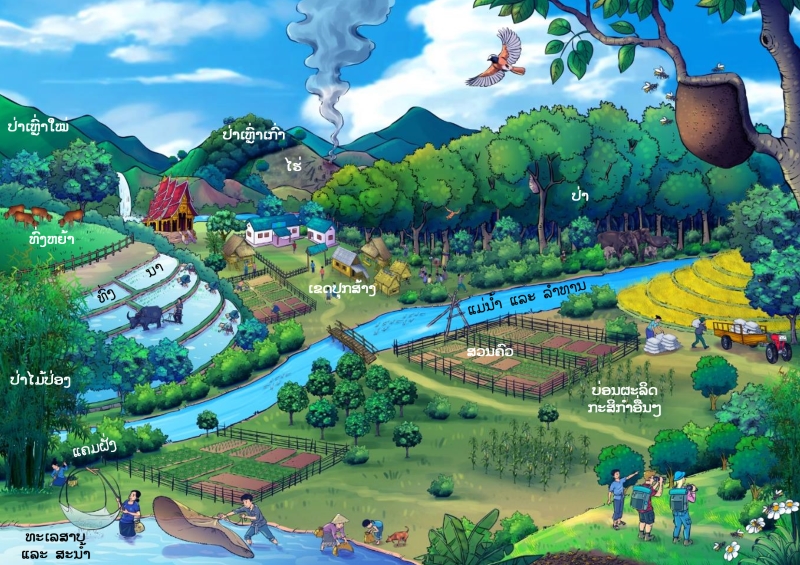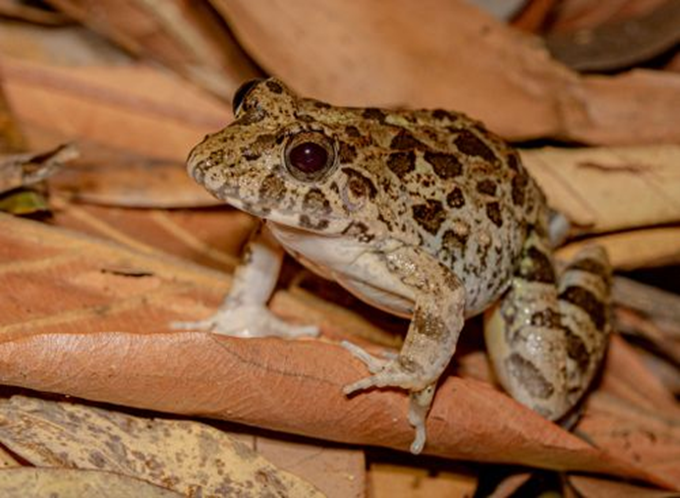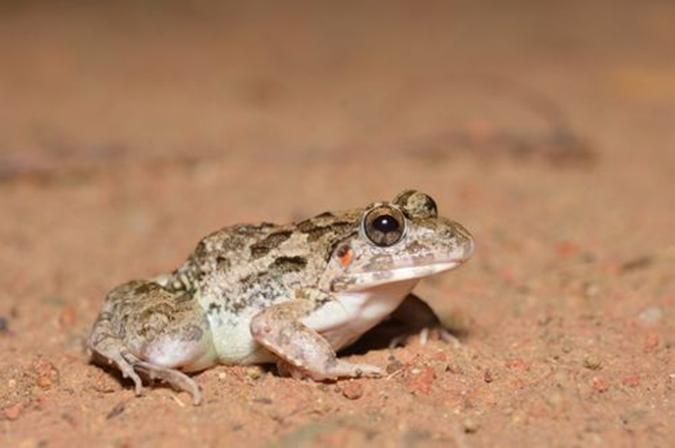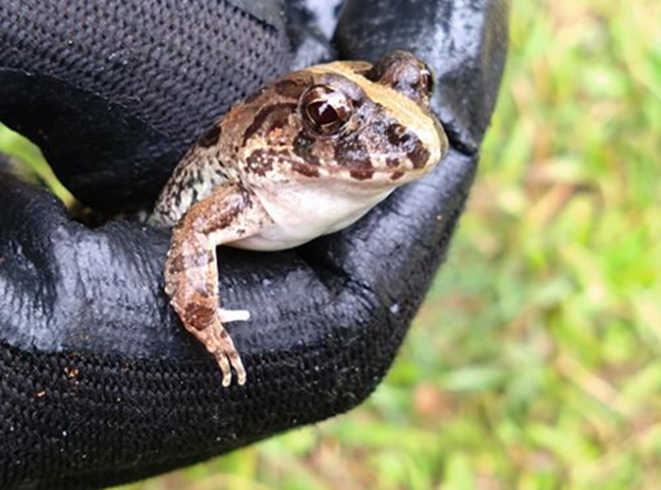ເລກລຳດັບທີ: 1683
ລະດັບການຮວບຮວມຂໍ້ມູນ: ເກີອບສົມບູນ
ປັບປູງຄັ້ງລ່າສຸດ: 2024-10-15
ຂຽດໂມ້
Asian Grass Frog
Fejervarya limnocharis (Gravenhorst, 1829)
ສັດ
ສັດເລືອຄານ
ສັດເຄິ່ງບົກເຄິ່ງນ້ຳ
×
ຊື່ທ້ອງຖີ່ນ:
ຂຽດອີ່ໂມ້, ຂຽດແມ່ໂມ້ ( Common Pond Frog, Field Frog, Grass Frog, Indian Rice Frog, Boie's Wart Frog)
ຊື່ພ້ອງ
:
Dicroglossus limnocharis (Gravenhorst, 1829)
Euphlyctis limnocharis (Gravenhorst, 1829)
Fejervarya wasl (Annandale, 1917)
Limnonectes limnocharis (Gravenhorst, 1829)
Rana limnocharis subsp. limnocharis Gravenhorst, 1829
Rana lymnocharis Gravenhorst, 1829
Rana wasl Annandale, 1917
Euphlyctis limnocharis (Gravenhorst, 1829)
Fejervarya wasl (Annandale, 1917)
Limnonectes limnocharis (Gravenhorst, 1829)
Rana limnocharis subsp. limnocharis Gravenhorst, 1829
Rana lymnocharis Gravenhorst, 1829
Rana wasl Annandale, 1917
ຊື່ສະກຸນ:
Dicroglossidae
ຊະນິດໃກ້ຄຽງ:
ຂຽດນ້ຳນອງ / Marten's puddle frog
ກົບຫອນ/ Capped frog
ຂຽດຈະນາ/ Common puddle frog
ກົບຫ້ວຍ/ Taylor's creek frog
ກົບຫອນ/ Capped frog
ຂຽດຈະນາ/ Common puddle frog
ກົບຫ້ວຍ/ Taylor's creek frog
ບັນຍາຍລັກສະນະທາງພືດສາດ:
ກົບຂະໜາດກາງນີ້ມີຄວາມຍາວແຕ່ 39 ຫາ 43 ມມ. ລັກສະນະເດັ່ນທີ່ສຸດແມ່ນມີດັງເເຫຼມຍື່ນອອກມາຍາວກວ່າປາກ ນອກຈາກກນີ້, ບໍລິເວນຫວ່າງຕາມີລັກສະນະກົມ, ໃນຂະນະທີ່ສັນດັງຂອງມັນມີລັກສະນະອຽງ ແລະ ຮູກ້ວາງເລັກນ້ອຍ. ຖ້າສັງເກດຈະເຫັນວ່າໄລຍະຫ່າງລະຫວ່າງຮູດັງຈະຫຼາຍກວ່າໄລຍະຫ່າງຂອງດວງຕາຂອງ ແລະ ເປືອກຕາດ້ານເທິງກ້ວາງກ່ວາດວງຕາຂອງມັນ, ແກ້ວຫູສັງເກດໄດ້ວ່າມີຂະໜາດປະມານເຄິ່ງໜຶ່ງຫາສອງສວນໃນສາມຂອງດວງຕາ, ນິ້ວມື ແລະ ນິ້ວຕີນຂອງຂຽດມີປາຍແຫຼມ ໂດຍທີ່ນິ້ວໂປ້ມືເປັນນິ້ວທີ່ຍາວທີ່ສຸດ ແລະ ຕຸ້ມນ້ອຍໆຢູ່ໃຕ້ຂໍ້ຕໍ່ຊ່ວຍໃຫ້ກົບຈັບພື້ນໄດ້ແໜ້ນ.
ແຫຼ່ງທີ່ມາ: [4]
ແຫຼ່ງທີ່ມາ: [4]
ນິເວດວິທະຍາ
ເຂດກະຈາຍພັນທົ່ວໂລກ:
Native to Bangladesh, Bhutan, Brunei Darussalam, Cambodia, India, Indonesia, Lao People's Democratic Republic, Malaysia, Myanmar, Nepal, Pakistan, Singapore, Sri Lanka, Thailand, Viet Nam.
Asian Grass Frog distribution from the last 20 years. [5]
Asian Grass Frog distribution from the last 20 years. [5]
ເຂດກະຈາຍພັນໃນລາວ
:
ເຂດພູສູງພາກເໜືອຂອງລາວ
ລຽບແມ່ນ້ຳຂອງພາກເໜືອ
ເຂດພູສູງສາຍພູຫຼວງ ແລະ ເຂດພູພຽງແຂວງຊຽງຂວາງ
ທົ່ງພຽງວຽງຈັນ
ເຂດສາຍພູຫຼວງພາກເໜືອ
ເຂດສາຍພູຫຼວງພາກກາງ
ເຂດສາຍພູຫຼວງຕອນລຸ່ມ
ສາຍພູຫຼວງພາກໃຕ້
ເຂດລຽບແມ່ນ້ຳຂອງພາກໃຕ້
ພູພຽງບໍລິເວນ
ລຽບແມ່ນ້ຳຂອງພາກເໜືອ
ເຂດພູສູງສາຍພູຫຼວງ ແລະ ເຂດພູພຽງແຂວງຊຽງຂວາງ
ທົ່ງພຽງວຽງຈັນ
ເຂດສາຍພູຫຼວງພາກເໜືອ
ເຂດສາຍພູຫຼວງພາກກາງ
ເຂດສາຍພູຫຼວງຕອນລຸ່ມ
ສາຍພູຫຼວງພາກໃຕ້
ເຂດລຽບແມ່ນ້ຳຂອງພາກໃຕ້
ພູພຽງບໍລິເວນ

ເຂດກະຈາຍພັນຕາມພູມສັນຖານ
:
ທົ່ງນາ
ທົ່ງຫຍ້າ
ປ່າປູກ
ເຂດຜະລິດພືດຜົນເນີນສູງ
ແຄມຝັ່ງນໍ້າ
ແມ່ນ້ຳ ແລະ ລຳທານ
ທະເລສາບ ແລະ ສະນ້ຳ
ໜອງບຶງ ແລະ ດິນຖານຕົມ
ສວນຄົວ
ສວນສາທາລະນະ ແລະ ພື້ນທີ່ສາທາລະນະ
ທົ່ງຫຍ້າ
ປ່າປູກ
ເຂດຜະລິດພືດຜົນເນີນສູງ
ແຄມຝັ່ງນໍ້າ
ແມ່ນ້ຳ ແລະ ລຳທານ
ທະເລສາບ ແລະ ສະນ້ຳ
ໜອງບຶງ ແລະ ດິນຖານຕົມ
ສວນຄົວ
ສວນສາທາລະນະ ແລະ ພື້ນທີ່ສາທາລະນະ

ສະເພາະຖິ່ນໃນລາວ:
ພື້ນເມືອງ
ຮຸກຮານ
:
ບໍ່ຮຸກຮານ
ສະຖານະພາບການອະນູຮັກ IUCN
:
ມີຄວາມສ່ຽງໜ້ອຍສຸດ
ສະຖານະພາບການອະນຸຮັກແຫ່ງຊາດລາວ
:
ບໍ່ຖືກລະບຸໃນບັນຊີປະເພດໃດ
ການນຳໃຊ້
ປະເພດການນຳໃຊ້:
ອາຫານ
ບັນຍາຍການນຳໃຊ້:
ອາຫານ: ຂຽດຊະນິດນີ້ຖືກເກັບກູ້ເພື່ອບໍລິໂພກເປັນອຫານຂອງມະນຸດ
ການປູກ ການລ້ຽງ:
ຊະນິດທຳມະຊາດ
ລະດູການເກັບກູ້:
ພຶກສະພາ
ມິຖຸນາ
ກໍລະກົດ
ສິງຫາ
ກັນຍາ
ຕຸລາ
ມິຖຸນາ
ກໍລະກົດ
ສິງຫາ
ກັນຍາ
ຕຸລາ
ການຕະຫຼາດ ແລະ ຕ່ອງໂສ້ມູນຄ່າ:
ການຄ້າ: ພົບເຫັນຢູ່ໃນຕະຫຼາດທ້ອງຖິ່ນ ແລະ ລະດັບຊາດ [6].
ການຄຸ້ມຄອງຈັດການ
ການອານຸລັກທີ່ຢູ່ອາໄສ:
ຊະນິດນີ້ບໍ່ໄດ້ຖືກໄພຂົ່ມຂູ່ຫຼາຍ. ເຖິງຢ່າງໃດກໍ່ຕາມ ໃນບາງພື້ນທີ່ຂອບເຂດທີ່ຢູ່ອາໄສຂອງມັນ, ຍັງພົບໄພຂົ່ມຂູ່ ເຊັນ: ການນໍາໃຊ້ສານເຄມີເຂົ້າໃນດ້ານກະສິກໍາ, ໂດຍສະເພາະແມ່ນການນໍາໃຊ້ຢາປາບສັດຕູພືດ, ການລະບາຍນ້ຳເສຍຈາກທີ່ຢູ່ອາໄສ, ແລະ ໄພແຫ້ງແລ້ງທີ່ກິນເວລານານ. ຂຽດບາງໂຕໄດ້ເກີດຄວາມຜິດປົກກະຕິທາງດ້ານສັນຖານວິທະຍາ ເຊິ່ງອາດຈະກ່ຽວຂ້ອງກັບການປົນເປື່ອນກັບສານເຄມີ. ໃນປະເທດໄທ ແລະ ປະເທດລາວມີການເກັບກູ້ເພື່ອການບໍລິໂພກຫຼາຍເກີນໄປໃນທ້ອງຖິ່ນ ຖືວ່າເປັນບັນຫາທີ່ນາກັງວົນ ນອກຈາກນີ້, ໃນປະເທດລາວຍັງມີການການປ່ຽນແປງຈາກທົງນາເປັນຕົວເມືອງ ເຊິ່ງກໍໃຫ້ເກີດເປັນໄພຂົ່ມຂູ່ອີກດ້ວຍ. [6]
ຊະນິດນີ້ບໍ່ໄດ້ຖືກໄພຂົ່ມຂູ່ຫຼາຍ. ເຖິງຢ່າງໃດກໍ່ຕາມ ໃນບາງພື້ນທີ່ຂອບເຂດທີ່ຢູ່ອາໄສຂອງມັນ, ຍັງພົບໄພຂົ່ມຂູ່ ເຊັນ: ການນໍາໃຊ້ສານເຄມີເຂົ້າໃນດ້ານກະສິກໍາ, ໂດຍສະເພາະແມ່ນການນໍາໃຊ້ຢາປາບສັດຕູພືດ, ການລະບາຍນ້ຳເສຍຈາກທີ່ຢູ່ອາໄສ, ແລະ ໄພແຫ້ງແລ້ງທີ່ກິນເວລານານ. ຂຽດບາງໂຕໄດ້ເກີດຄວາມຜິດປົກກະຕິທາງດ້ານສັນຖານວິທະຍາ ເຊິ່ງອາດຈະກ່ຽວຂ້ອງກັບການປົນເປື່ອນກັບສານເຄມີ. ໃນປະເທດໄທ ແລະ ປະເທດລາວມີການເກັບກູ້ເພື່ອການບໍລິໂພກຫຼາຍເກີນໄປໃນທ້ອງຖິ່ນ ຖືວ່າເປັນບັນຫາທີ່ນາກັງວົນ ນອກຈາກນີ້, ໃນປະເທດລາວຍັງມີການການປ່ຽນແປງຈາກທົງນາເປັນຕົວເມືອງ ເຊິ່ງກໍໃຫ້ເກີດເປັນໄພຂົ່ມຂູ່ອີກດ້ວຍ. [6]
ໂພຊະນາການ
ຄຸນຄ່າທາງໂພຊະນາການ:
ບັນຍາຍຄຸນຄ່າທາງໂພຊະນາການ:
N/A
| ສານອາຫານ | /100g | ໝາຍເຫດ |
|---|---|---|
| ໂປຣຕີນ | N/A | N/A |
| ຄາໂບໄຮເດຣດ | N/A | N/A |
| ໄຂມັນ | N/A | N/A |
| ວິຕາມິນ | N/A | N/A |
| ແຮ່ທາດ | N/A | N/A |
| ເສັ້ນໄຍ | N/A | N/A |
ອ້າງອິງ
ເຄດິດຮູບພາບ:
Asian Grass Frog on top of leaves. [1] iNaturalist [Online]. Uploaded on 18 February 2024 by: buggingout365. Available: www.inaturalist.org/photos/352335263. [Accessed: 18 Septem-ber 2024]
Asian Grass Frog, side profile. [2] iNaturalist [Online]. Uploaded on 21 April 2024 by: wuttikarn-sriraksa. Available: www.inaturalist.org/photos/369303181. [Accessed: 18 September 2024]
Captured Asian Grass Frog. [3] iNaturalist [Online]. Uploaded on 21 January 2024 by: benny85. Available: www.inaturalist.org/photos/347493157. [Accessed: 18 September 2024]
Asian Grass Frog, side profile. [2] iNaturalist [Online]. Uploaded on 21 April 2024 by: wuttikarn-sriraksa. Available: www.inaturalist.org/photos/369303181. [Accessed: 18 September 2024]
Captured Asian Grass Frog. [3] iNaturalist [Online]. Uploaded on 21 January 2024 by: benny85. Available: www.inaturalist.org/photos/347493157. [Accessed: 18 September 2024]
ອ້າງອິງ:
[4] ThaiNationalParks. (2024, February 1). Thai national parks. Retrieved from thainationalparks.com: https://www.thainationalparks.com/species/fejervarya-limnocharis.
[5] GBIF [Online]. Available: https://www.gbif.org/species/2430396. [Accessed: 18 September 2024]
[6] IUCN SSC Amphibian Specialist Group, “Fejervarya limnocharis,” The IUCN Red List of Threatened Species 2023: e.T48886659A68126024, [Online]. Available: https://dx.doi.org/10.2305/IUCN.UK.2023-1.RLTS.T48886659A68126024.en. [Accessed: 18 September 2024].
[5] GBIF [Online]. Available: https://www.gbif.org/species/2430396. [Accessed: 18 September 2024]
[6] IUCN SSC Amphibian Specialist Group, “Fejervarya limnocharis,” The IUCN Red List of Threatened Species 2023: e.T48886659A68126024, [Online]. Available: https://dx.doi.org/10.2305/IUCN.UK.2023-1.RLTS.T48886659A68126024.en. [Accessed: 18 September 2024].
ຜູ້ສ້າງ Factsheet:
ຜູ້ກວດສອບ Factsheet:
,


